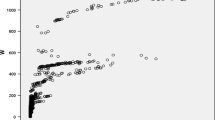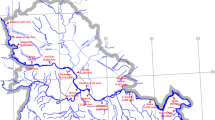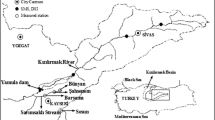Abstract
Regime width of alluvial channels is a vital problem in river morphology and channel design. Many equations are available in the literature to predict regime width of alluvial rivers. In general, there are many approaches to estimate regime width; however, none of them is widely accepted at present. This is due to the fact that most hypotheses have many constrains which may lead to simplify governing conditions and also lack of knowledge of some physical processes associated with channel formation and maintenance. Intelligent models are a new approach to describe complex problems one of which is artificial neural networks. In this research, initially, gravel bed rivers database was used in bankfull discharge condition to train various dimensional and non-dimensional neural-network schemes with three and four variables as input data, respectively. Then, the same database was applied to fit regression analysis to estimate regime width; this led to drive dimensional and non-dimensional equations. Finally, dimensional and non-dimensional neural-network models and regression equations were compared together based on 50% error bands with other dataset. Results show that neural network can adequately estimate the regime width in gravel bed rivers and multilayer perceptron network with one hidden layer and eight hidden neurons based on dimensional data set was selected as optimum network to predict regime width. A sensitivity analysis also shows that bankfull discharge has a greater influence on regime width of gravel bed channels than the other independent parameters in dimensional scheme of neural network.









Similar content being viewed by others
References
Andrews ED (1984) Bed-material entrainment and hydraulic geometry of gravel-bed rivers in Colorado. Bull Geol Soc Am 95(3):371–378
Arbeláez AC, Guevara ME, Posada L, González LJ, Gallardo C A (2007) Regime Equations for Mountain Streams in the Cauca Region of Colombia, Hydrology Days Conference, pp 177–188
ASCE Task committee (2000) Artificial neural networks in hydrology: hydrologic applications. J Hydrol Eng 5(2):124–137
ASCE Task Committee on Hydraulics (1998) Bank Mechanics and modeling of river width adjustment 1: processes and mechanisms. J Hydraul Eng ASCE 124(9):881–902
Azmathullah HM, DEo MC, Deolalikar PB et al (2005) Neural network for estimation of scour downstream of a ski-jump bucket. J Hydra Eng 131(10):898–908
Azmathullah HM, DEo MC, Deolalikar PB (2006) Estimation of scour below spillways using neural networks. J Hydraul Res 44(1):61–69
Bandyopadhyay G, Chattopadhyay S (2007) Single hidden layer artificial neural network models versus multiple linear regression model in forecasting the time series of total ozone. Int J Environ Sci Tech 4(1):141–149
Bateni SM, Borghei SM, Jeng DS (2007) Neural network and neuro-fuzzy assessments for scour depth around bridge piers. Eng Appl Artif Intell 20:401–414
Bathurst JC (1985) Flow resistance estimation in mountain rivers. J Hydraul Eng 111(4):625–643
Bray DI (1982) Regime equations for gravel-bed rivers. In: Hey RD, Bathurst JC, Thorne CR (eds) Gravel Bed Rivers: Fluvial Processes. Eng Manag, pp 517–541
Chang HH (1988) Fluvial Processes in River Engineering. Wiley, NewYork
Charlton FG, Brown PM, Benson RW (1978) The hydraulic geometry of some gravel rivers in Britain: report INT 180. Hydraulics Research Station, Wallingford, p 48
Christiane I, Mulvihill CI, Filopowicz A, Coleman A, Baldigo BP (2007) Regionalized equations for bankfull discharge and channel characteristics of streams in New York State Hydrologic Regions 1 and 2 in the Adirondack Region of Northern New York: U.S. Geological Survey Scientific Investigations Report 2007–5189
Engelund F, Hansen E (1972) A monograph on sediment transport in alluvial streams. Teknisk Forlag, Copenhagen
Farias HD, Pilan MT, Mattar MT, Pece FJ (1998) Regime width of alluvial channels: conciliation of several approaches parallel session. (parallel45), Basics of Sediment Transport and Scouring
Glover RE, Florey QL (1951) Stable channel profiles. U.S. Bureau of Reclamation, Washington, DC
Hecht-Nielsen (1987) Neurocomputing picking the human brain. IEEE Spectrum 25(3):36–41
Hey RD, Thorne CR (1986) Stable channels with mobile gravel beds. J Hydraul Eng 112(8):671–689
Huang HQ, Nason GC (2000) Hydraulic geometry and maximum flow efficiency as products of the principle of least action. Earth Surf Process Land 25:1–16
Jia Y (1990) Minimum Froude number and the equilibrium of alluvial sand rivers. Earth Surface Proc Land Forms 15:199–209
Julien PY, Wargadalam J (1995) Alluvial channel geometry: theory and applications. J Hydraul Eng 121(4):312–325
Kallio BSSE (2010) Determining the bankfull discharge exceedance potential of agricultural ditches in Ohio: M.Sc. dissertation. Ohio State University, Ohio
Kambekar AR, Deo MC (2003) Estimation of group pile scour using neural networks. Appl Ocean Res 25(4):225–234
Kellerhals R, Neill CR, Bray DI (1972) Hydraulic and geomorphic characteristics of rivers in Alberta: river engineering and surface hydrology report. Research Council of Alberta, Canada (No 721)
Kumar DN, Ray A (1997) Application of artificial neural network for rainfall-runoff modeling. Proc. National Conf. on Fluid Mechanics and Fluid Power. Department of Applied Mechanics, Bangal Engineering College, Howra, india, December 26–28, D58–D61
Kuok KK, Harun S, Shamsuddin SM (2009) Particle swarm optimization feedforward neural network for modeling runoff. Int J Environ Sci Tech 7(1):67–78
Lacey G (1930) Stable channels in alluvium: minutes of the proceeding. Inst of Civ Engrs 229:259–292
Lane EW (1955) Design of stable canals. Transactions, ASCE 120:1234–1260
Leopold LB, Maddock T (1953) The hydraulic geometry of stream channels and some physiographic implications. US Geological Survey Professional Paper 252
Liriano SL, Day RA (2001) Prediction of scour depth at culvert outlets using neural networks. J Hydroinformatics 3(4):231–238
McCandless TL (2003) Maryland stream survey: bankfull discharge and channel characteristics of streams in the Allegheny Plateau. U.S. Fish and Wildlife Service Chesapeake Bay Field Office. p 33
Muzzammil M (2008) Application of neural networks to scour depth prediction at the bridge abutments. Eng Appl Comp Fluid Mech 2(1):30–40
Nagy HM, Watanabe K, Hirano M (2002) Prediction of sediment load concentration in river using artificial neural network model. J Hydraulic Eng ASCE 128(6):588–595
Parker G (1978) Self-formed straight rivers with equilibrium banks and mobile bed. Part 2: the gravel river. J Fluid Mech 89(1):127–146
Parker G, Toro-Escobar CM, Ramey M, Beck S (2003) Effect of floodwater extraction on the morphology of mountain streams. JHydraul Eng 129(11):885
Parola AC, Skinner K, Curini ALW, Vesely WS, Hansen C, Jones MS (2005) Bankfull characteristics of select streams in the four rivers and upper Cumberland river basin management. University of Louisville and Kentucky Environmental and public Protection Cabinet. p 39
Pitlick J, Cress R (2002) Downstream changes in the channel of a large gravel bed river. Water Resour Res 38(10):1216–1226
Rajaee T, Mirbagheri SA, Nourani V, Alikhani A (2009) Prediction of daily suspended sediment load using wavelet and neurofuzzy combined model. Int J Environ Sci Tech 7(1):93–110
Rinaldi M (2003) Recent channel adjustments in alluvial rivers of Tuscany, central Italy. Earth Surf Process Landforms 28(6):587–608
Sherwood JM, Huitger CA (2005) Bankfull charachtristics of Ohio streams and their relation to peak stream-flow. U.S. Geological Survey Scientific Investigations Report 2005–5153
Shirkhani R (2010) An experimental study of effect of flow variation on river bank erosion: M.Sc. dissertation. Dept of Civ Eng, Amirkabir University of Technology, Tehran
Singh VP, Deng ZQ, Yang CT (2003) Downstream hydraulic geometry relations using the principles of minimum energy dissipation rate and maximum Entropy, Part I and Part II. Water Resources Research
Tahershamsi A, Menhaj MB, Ahmadian R (2006) Sediment loads prediction using multilayer feed forward neural networks. Amirkabir 16(63):103–110
Tu JV (1996) Advantages and disadvantages of using artificial neural networks versus logistic regression for predicting medical outcomes. J Clin Epidemiol 49(11):1225–1231
Van den Berg JH (1995) Prediction of alluvial channel pattern of perennial rivers. Geomorphology 12(4):259–279
Wang J, Sui J, Guo L, Karney BW, Jüpner R (2010) Forecast of water level and ice jam thickness using the back propagation neural network and support vector machine methods. Int J Environ Sci Tech 7(2):215–224
Wohl EE, Wilcox A (2005) Channel geometry of mountain streams in New Zealand. J Hydrol 300(1):252–266
Wohl E, Kuzma JN, Brown NE (2004) Reach-Scale channel geometry of a mountain river. Earth Surf Process Landforms 29(8):969–981
Zweiri YH, Whidborne JF, Sceviratne LD (2003) A three-term backpropagation algorithm. Neurocomputing 50:305–318
Author information
Authors and Affiliations
Corresponding author
Rights and permissions
About this article
Cite this article
Tahershamsi, A., Majdzade Tabatabai, M.R. & Shirkhani, R. An evaluation model of artificial neural network to predict stable width in gravel bed rivers. Int. J. Environ. Sci. Technol. 9, 333–342 (2012). https://doi.org/10.1007/s13762-012-0036-8
Received:
Revised:
Accepted:
Published:
Issue Date:
DOI: https://doi.org/10.1007/s13762-012-0036-8




